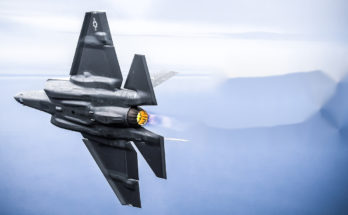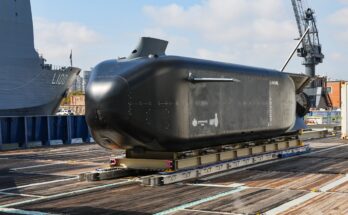
Collins class submarines HMAS Collins, Farncomb, Dechaineux and Sheean in formation while transiting through Cockburn Sound, Western Australia. – Australian DoD
Australia’s cancellation of its contract with France’s Naval Group for 12 Shortfin Barracuda class submarines (the Shortfin being a conventionally powered variant of the nuclear-powered Barracuda) in favor of American technology-backed nuclear submarines has sent economic and political shockwaves throughout the world. Such “overt” intervention into Asian waters by the U.K. and the U.S. will likely see a swift, chest-beating response by China through an increased buildup of outposts in the Spratly Islands, as well as an acceleration in the pace of warship construction, which is already running high.
For perspective on this decision, the following provides some background on the world submarine market and offers insight into the positions of the major players.
Interestingly, as nations face funding crises and are compelled to make cuts in their naval force structures, their submarine fleets tend to be the least affected by these economies. While both surface ships and submarines may be reduced in number and suffer delays as their obsolete tonnage is replaced, it will be the submarines that survive the longest. This is because submarine fleets offer a cost-effective means of delivering naval firepower that is unmatched by any other unit, save the nuclear-powered aircraft carrier.
The submarine market is also affected by purely political issues. The ship-killing capability of modern submarines means that they are a major component of the offensive capability displayed by a fleet. Thus, to be taken seriously as a regional naval power, a country has to deploy a viable submarine force.
Nuclear-powered attack submarines take this ship-killing capability and add unprecedented strategic mobility that allows rapid worldwide deployment. Thus, to be taken seriously as a world naval power, a nation has to operate SSNs. These political considerations drive submarine demand as effectively as any operational or strategic motivations do.
Of late there has been an increasing perception, in the United States in particular, that the current submarine fleets are inadequate in numbers to face the demands placed upon them. This perception is being matched by increased submarine procurement. Should this trend hold, the market prospects for the submarine sector are optimistic.
To be considered a player in the current undersea warfare marketplace, a company must remain prudent enough to keep from torpedoing itself and bold enough not to stall before capitalizing on the full potential of the market. Companies need to stay sharp and remain focused on offering special features, competitive prices, high performance and reliability, and customer support – all of which can be selling points for electronics equipment in a market where one wrong turn in technology development can lead to failure.
Can Nuclear Submarines Save Australia from a Chinese Onslaught?
The undersea warfare market is characterized by a diversification/consolidation cycle wherein the development of new technology causes several niche market leaders – individual companies with a strong presence in specific areas – to emerge. Then, as the market matures, corporate giants acquire these smaller companies and add them to their world conglomerate. This process continues until a new generation of technology becomes dominant, leading to a new influx of small groups, some of which will become the giants of the future. The required industrial skills and equipment portfolios appear to rest with France, Germany, the United Kingdom, and the United States. The process by which the three naval industry-oriented European countries rationalized their businesses down to a single player is now being followed by a further rationalization in which those single-country entities are merging on a transnational basis. Only in the U.S. is there significant domestic competition, but this is becoming less so as more and more mergers and acquisitions take place.
Since the fall of the Soviet Union, Russia has had ambitions of emerging as a world player, but these efforts were, for many years, doomed to frustration. Russian equipment remained largely confined to Russia’s platforms sold to a small number of traditional clients.
There is a resurgence of interest in undersea warfare following years of neglect in favor of airborne and land-based operations. This revival is being driven by China’s increasing aggression in the South China Sea around the Spratly Islands; Russia’s quiet increase in its Arctic fleet to take advantage of climate change, which is opening new sea lanes and allowing previously inaccessible natural resources to be exploited; and ever-aggressive rants coming out of North Korea.
By the time Australia gets its first “American” nuclear submarine operational around 2040, the area of the South China Sea around the Spratly Islands may already have become the Beijing Riviera. As much as China is known for playing the long game (in many cases decades), it is not going to wait that long.
With a 30-year head start in the region, China will likely go all in – backed by its global economic clout – before the rest of the world can respond rapidly enough conventionally and diplomatically.
With the agreement by the U.S. to impart its sensitive nuclear submarine technology to Canberra, Australia’s role in the Asia-Pacific Great Game only became larger and deeper. There is no longer a question of Canberra hedging between Washington and Beijing – and hasn’t been since the release of the Australian government’s 2020 Defence Strategic Update. Australia has made a strategic bet on the U.S. side in the event of a future dispute with China.
For more than 30 years, Richard has performed numerous roles as a top analyst for Forecast International. Currently, Richard is the Group Leader and Lead Analyst for Forecast International's Traditional Defense Systems, which covers all aspects of naval warfare, military vehicles, ordnance and munitions, missiles, and unmanned vehicles.
Having previously been Forecast International's Electronics Group Leader for 20-plus years, Richard established Electro-Optical Systems Forecast, as well as having been the prime editor of Electronic Systems Forecast, Land & Sea-Based Electronics Forecast, and C4I Forecast. Additionally, Richard has served as the Naval Systems Group Leader responsible for Anti-Submarine Warfare Forecast andWarships Forecast.




